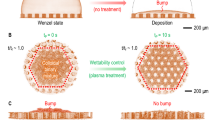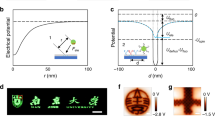Abstract
Micropatterning of surfaces with several chemicals at different spatial locations usually requires multiple stamping and registration steps. Here, we describe an experimental method based on reaction–diffusion phenomena that allows for simultaneous micropatterning of a substrate with several coloured chemicals. In this method, called wet stamping (WETS), aqueous solutions of two or more inorganic salts are delivered onto a film of dry, ionically doped gelatin from an agarose stamp patterned in bas relief. Once in conformal contact, these salts diffuse into the gelatin, where they react to give deeply coloured precipitates. Separation of colours in the plane of the surface is the consequence of the differences in the diffusion coefficients, the solubility products, and the amounts of different salts delivered from the stamp, and is faithfully reproduced by a theoretical model based on a system of reaction–diffusion partial differential equations. The multicolour micropatterns are useful as non-binary optical elements, and could potentially form the basis of new applications in microseparations and in controlled delivery.
This is a preview of subscription content, access via your institution
Access options
Subscribe to this journal
Receive 12 print issues and online access
$259.00 per year
only $21.58 per issue
Buy this article
- Purchase on Springer Link
- Instant access to full article PDF
Prices may be subject to local taxes which are calculated during checkout





Similar content being viewed by others
References
Choudhury, P.R. (ed.) Handbook of Microlithography, Micromachining, and Microfabrication (SPIE, Bellingham, 1997).
Michel, B. et al. Printing meets lithography: Soft approaches to high-resolution printing. IBM J. Res. Dev. 45, 697–719 (2001).
Tolfree, D.W.L. Microfabrication using synchrotron radiation. Rep. Prog. Phys. 61, 313–351 (1998).
Thompson, L.F. & Kerwin, R.E. Polymer resist systems for photolithography and electron lithography. Ann. Rev. Mater. Sci. 6, 267–301 (1976).
Xia, Y. & Whitesides, G.M. Soft lithography. Angew. Chem. Int. Edn 37, 551–575 (1998).
Xia, Y., Rogers, J.A., Paul, K.E. & Whitesides, G.M. Unconventional methods for fabricating and patterning nanostructures. Chem. Rev. 99, 1823–1848 (1999).
Delamarche, E. et al. Microcontact printing using poly(dimethylsiloxane) stamps hydrophilized by poly(ethylene oxide) silanes. Langmuir 19, 8749–8758 (2003).
Kind, H. et al. Printing gel-like catalysts for the directed growth of multiwall carbon nanotubes. Langmuir 16, 6877–6883 (2003).
Renault, J.P. et al. Fabricating arrays of single protein molecules on glass using microcontact printing. J. Phys. Chem. B 107, 703–711 (2003).
Rogers, J.A. et al. Paper-like electronic displays: Large-area rubber-stamped plastic sheets of electronics and microencapsulated electrophoretic inks. Proc. Natl Acad. Sci. 98, 4835–4840 (2001).
Tien, J., Nelson, C.M. & Chen, C.S. Fabrication of aligned microstructures with a single elastomeric stamp. Proc. Natl Acad. Sci. 99, 1758–1762 (2002).
Chen, C., Hirdes, D. & Folch, A. Gray-scale photolithography using microfluidic photomasks. Proc. Natl Acad. Sci. 100, 1499–1504 (2003).
Frank, M., Schallenberg, U.B. & Kaiser, N. Micropatterned multilayer dielectric filters with two spectral characteristics. Opt. Eng. 36, 1220–1224 (1997).
Peng, Q. et al. Real-time photolithographic technique for fabrication of arbitrarily shaped microstructures. Opt. Eng. 42, 477–481 (2003).
Fosser, K.A. & Nuzzo, R.G. Fabrication of patterned multicomponent protein gradients and gradient arrays using microfluidic depletion. Anal. Chem. 75, 5775–5782 (2003).
Dertinger, S.K.W., Jiang, X.Y., Li, Z.Y., Murthy, V.N. & Whitesides, G.M. Gradients of substrate-bound laminin orient axonal specification of neurons. Proc. Natl Acad. Sci. 99, 12542–12547 (2002).
Wong, J.Y., Velasco, A., Rajagopalan, P. & Pham, Q. Directed movement of vascular smooth muscle cells on gradient-compliant hydrogels. Langmuir 19, 1908–1913 (2003).
Henisch, H.K. Periodic Precipitation (Pergamon, Oxford, 1991).
Turing, A.M. The chemical basis of morphogenesis. Phil. Trans. R. Soc. B 237, 37–72 (1952).
Zhabotinsky, A.M. & Zaikin, A.N. Concentration wave propagation in two-dimensional liquid phase self-oscillating system. Nature 225, 535–537 (1970).
Lengyel, I. & Epstein, I.R. Modeling of Turing structures in the chlorite–iodide–malonic acid–starch reaction system. Science 251, 650–652 (1991).
Ouyang, Q. & Swinney, H.L. Transition from a uniform state to hexagonal and striped Turing patterns. Nature 352, 610–612 (1991).
Hess, B. & Mikhailov, A. Self-organization in living cells. Science 264, 223–224 (1994).
Bussemas, H.H. & Ettre, L.S. Forerunners of chromatography: Runge's self-grown pictures. LC GC N. Am. 22, 262–270 (2004).
Fialkowski, M., Campbell, C.J., Bensemann, I.T. & Grzybowski, B.A. Absorption of water by thin, ionic films of gelatin. Langmuir 20, 3513–3516 2004.
Tananayev, I.V., Glushkova, M.A. & Seifer, B.G. Series of ferrocyanide solubilities. Zh. Neorg. Khim. 1, 66–69 (1956).
Valente, A.J.M., Polishchuk, A. Ya., Lobo, V.M.M. & Geuskens, G. Diffusion coefficients of lithium chloride and potassium chloride in hydrogel membranes derived from acrylamide. Eur. Polym. J. 38, 13–18 (2002).
Krajewska, B. Diffusion of metal ions through gel chitosan membranes. Reactive Funct. Polym. 47, 37–47 (2003).
Ames, W.F. Numerical Methods for Partial Differential Equations (Academic, New York 1977).
Gao, P. & Fagerness, P.E. Diffusion in HPMC gels. 1. Determination of drug and water diffusivity by pulsed-field-gradient spin-echo NMR. Pharm. Res. 12, 955–964 (1995).
Masaro, L. & Zhu, X.X. Physical models of diffusion for polymer solutions, gels and solids. Prog. Polym. Sci. 24, 731–755 (1999).
Hantz, P. Regular microscopic patterns produced by simple reaction–diffusion systems. Phys. Chem. Chem. Phys. 4, 1262–1267 (2002).
Guzman, N.A. & Stubbs, R.J. The use of selective adsorbents in capillary electrophoresis-mass spectrometry for analyte preconcentration and microreactions: A powerful three-dimensional tool for multiple chemical and biological applications. Electrophoresis 22, 3602–3628 (2001).
LaVan, D.A., McGuire, T. & Langer, R. Small-scale systems for in vivo drug delivery. Nature Biotechnol. 21, 1184–1191 (2003).
Acknowledgements
This work was supported by the Northwestern University start-up funds. B.A.G. gratefully acknowledges financial support from the Camille and Henry Dreyfus New Faculty Awards Program. M.F. was supported by the NATO Scientific Fellowship, and C.C. and K.B. by the NSF-IGERT Dynamics of Complex Systems in Science and Engineering Graduate Fellowship.
Author information
Authors and Affiliations
Corresponding author
Ethics declarations
Competing interests
The authors declare no competing financial interests.
Supplementary information
Rights and permissions
About this article
Cite this article
Klajn, R., Fialkowski, M., Bensemann, I. et al. Multicolour micropatterning of thin films of dry gels. Nature Mater 3, 729–735 (2004). https://doi.org/10.1038/nmat1231
Received:
Accepted:
Published:
Issue Date:
DOI: https://doi.org/10.1038/nmat1231
This article is cited by
-
Free-standing supramolecular hydrogel objects by reaction-diffusion
Nature Communications (2017)
-
Biomineralization-inspired approach to the development of hybrid materials: preparation of patterned polymer/strontium carbonate thin films using thermoresponsive polymer brush matrices
Polymer Journal (2014)
-
Reversible patterning and actuation of hydrogels by electrically assisted ionoprinting
Nature Communications (2013)
-
Molecular dynamics imaging in micropatterned living cells
Nature Methods (2005)



